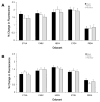Ontogeny of the enhanced fetal-ethanol-induced behavioral and neurophysiologic olfactory response to ethanol odor
- PMID: 19951301
- PMCID: PMC3435116
- DOI: 10.1111/j.1530-0277.2009.01083.x
Ontogeny of the enhanced fetal-ethanol-induced behavioral and neurophysiologic olfactory response to ethanol odor
Abstract
Background: Studies report a fundamental relationship between chemosensory function and the responsiveness to ethanol, its component orosensory qualities, and its odor as a consequence of fetal ethanol exposure. Regarding odor, fetal exposed rats display enhanced olfactory neural and behavioral responses to ethanol odor at postnatal (P) day 15. Although these consequences are absent in adults (P90), the behavioral effect has been shown to persist into adolescence (P37). Given the developmental timing of these observations, we explored the decay in the response to ethanol odor by examining ages between P37 and young adulthood. Moreover, we sought to determine whether the P15 neurophysiologic effect persists, at least, to P40.
Methods: Behavioral and olfactory epithelial (OE) responses of fetal ethanol exposed and control rats were tested at P40, P50, P60, or P70. Whole-body plethysmography was used to quantify each animal's innate behavioral response to ethanol odor. We then mapped the odorant-induced activity across the OE in response to different odorants, including ethanol, using optical recording methods.
Results: Relative to controls, ethanol exposed animals showed an enhanced behavioral response to ethanol odor that, while significant at each age, decreased in magnitude. These results, in conjunction with previous findings, permitted the development of an ontologic odor response model of fetal exposure. The fitted model exemplifies that odor-mediated effects exist at birth, peak in adolescence and then decline, becoming absent by P90. There was no evidence of an effect on the odor response of the OE at any age tested.
Conclusions: Fetal exposure yields an enhanced behavioral response to ethanol odor that peaks in adolescence and wanes through young adulthood. This occurs absent an enhanced response of the OE. This latter finding suggests that by P40 the OE returns to an ethanol "neutral" status and that central mechanisms, such as ethanol-induced alterations in olfactory bulb circuitry, underlie the enhanced behavioral response. Our study provides a more comprehensive understanding of the ontogeny of fetal-ethanol-induced olfactory functional plasticity and the behavioral response to ethanol odor.
Figures



Similar articles
-
The interaction of gestational and postnatal ethanol experience on the adolescent and adult odor-mediated responses to ethanol in observer and demonstrator rats.Alcohol Clin Exp Res. 2010 Oct;34(10):1705-13. doi: 10.1111/j.1530-0277.2010.01257.x. Epub 2010 Jul 5. Alcohol Clin Exp Res. 2010. PMID: 20608909 Free PMC article.
-
Experience-induced fetal plasticity: the effect of gestational ethanol exposure on the behavioral and neurophysiologic olfactory response to ethanol odor in early postnatal and adult rats.Behav Neurosci. 2007 Dec;121(6):1293-305. doi: 10.1037/0735-7044.121.6.1293. Behav Neurosci. 2007. PMID: 18085882 Free PMC article.
-
Gestational ethanol exposure alters the behavioral response to ethanol odor and the expression of neurotransmission genes in the olfactory bulb of adolescent rats.Brain Res. 2009 Feb 3;1252:105-16. doi: 10.1016/j.brainres.2008.11.023. Epub 2008 Nov 19. Brain Res. 2009. PMID: 19063871 Free PMC article.
-
Fetal alcohol syndrome: early olfactory learning as a model system to study neurobehavioral deficits.Int J Neurosci. 1997 Jan;89(1-2):119-32. doi: 10.3109/00207459708988467. Int J Neurosci. 1997. PMID: 9134450 Review.
-
Fetal or infantile exposure to ethanol promotes ethanol ingestion in adolescence and adulthood: a theoretical review.Alcohol Clin Exp Res. 2005 Jun;29(6):909-29. doi: 10.1097/01.alc.0000171046.78556.66. Alcohol Clin Exp Res. 2005. PMID: 15976517 Review.
Cited by
-
Fetal alcohol exposure leads to abnormal olfactory bulb development and impaired odor discrimination in adult mice.Mol Brain. 2011 Jul 7;4:29. doi: 10.1186/1756-6606-4-29. Mol Brain. 2011. PMID: 21736737 Free PMC article.
-
Fetal Alcohol Spectrum Disorder (FASD) Associated Neural Defects: Complex Mechanisms and Potential Therapeutic Targets.Brain Sci. 2013 Jun 19;3(2):964-91. doi: 10.3390/brainsci3020964. Brain Sci. 2013. PMID: 24961433 Free PMC article.
-
Prenatal alcohol exposure increases postnatal acceptability of nicotine odor and taste in adolescent rats.PLoS One. 2014 Jul 16;9(7):e102255. doi: 10.1371/journal.pone.0102255. eCollection 2014. PLoS One. 2014. PMID: 25029285 Free PMC article.
-
Lithium prevents long-term neural and behavioral pathology induced by early alcohol exposure.Neuroscience. 2012 Mar 29;206:122-35. doi: 10.1016/j.neuroscience.2011.12.059. Epub 2012 Jan 8. Neuroscience. 2012. PMID: 22266347 Free PMC article.
-
The interaction of gestational and postnatal ethanol experience on the adolescent and adult odor-mediated responses to ethanol in observer and demonstrator rats.Alcohol Clin Exp Res. 2010 Oct;34(10):1705-13. doi: 10.1111/j.1530-0277.2010.01257.x. Epub 2010 Jul 5. Alcohol Clin Exp Res. 2010. PMID: 20608909 Free PMC article.
References
-
- Abate P, Pepino MY, Dominguez HD, Spear NE, Molina JC. Fetal associative learning mediated through maternal alcohol intoxication. Alcohol Clin Exp Res. 2000;24:39–47. - PubMed
-
- Abate P, Spear NE, Molina JC. Fetal and infantile alcohol-mediated associative learning in the rat. Alcohol Clin Exp Res. 2001;25:989–998. - PubMed
-
- Abel EL, Yourk JL. Absence of effect of prenatal ethanol on adult emotionality and ethanol consumption in rats. J Stud Alcohol. 1979;40:547–553. - PubMed
-
- Alati R, Al Mamum A, Williams GM, O’Callagham M, Najman JM, Bor W. In utero alcohol exposure and prediction of alcohol disorders in early adulthood: a birth cohort study. Arch Gen Psychiatry. 2006;63:1009–1016. - PubMed
-
- Arias C, Chotro MG. Interactions between prenatal ethanol exposure and postnatal learning about ethanol in rat pups. Alcohol. 2006;40:51–59. - PubMed
Publication types
MeSH terms
Substances
Grants and funding
LinkOut - more resources
Full Text Sources
Research Materials

